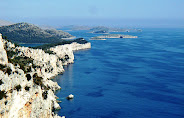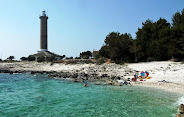 The island of Cres, by size the first island in the Adriatic, is located in the northern part of the Bay of Kvarner. Its southern part, i.e. the town of Osor, is linked to the island of Lošinj by a trestle bridge. Cres is a hilly island, 66 km long and ranging in width from 2 to 12 km. The island's coastline , 248 km long, is indented; its western and southern part have a plenty of bays and pebbly beaches while the northern and eastern part are characterized with steep and rough rocks. The highest tops of the island - Gorice (648m) and Sis (638) - offer a unique view of the Bay of Kvarner which will not leave anyone indifferent. The fresh water lake of Vrana, which covers the area of 5. 75 square kilometres , deserves attention as an unusual natural phenomenon. The level of the lake is above the level of the surrounding sea, and its bottom is beneath the sea level only at the depth of 74 m. The landscape of Cres owes its attractivity to a sharp contrast between the northern sub mediterranean part covered with high and thick woods of oak medunac (Quercus lanuginosa) , hornbeam, elm, and chestnut trees, and the middle and southern parts which are covered with bare grazing lands and dense macchia. A great richness of the botanical and animal world, which boasts more than 1300 species and an exceptional number of endemic species, is a genuine challenge to all nature lovers. Cres is also one of the last habitats of a rare bird species - griffon vulture. The island of Cres was first inhabited in the New Stone Age. The continuity of life on the island has created an exceptionally rich cultural and historical heritage: from a number of Liburnian ruins, the remains of Antique towns, early Catholic churches scattered around the island, monaste
The island of Cres, by size the first island in the Adriatic, is located in the northern part of the Bay of Kvarner. Its southern part, i.e. the town of Osor, is linked to the island of Lošinj by a trestle bridge. Cres is a hilly island, 66 km long and ranging in width from 2 to 12 km. The island's coastline , 248 km long, is indented; its western and southern part have a plenty of bays and pebbly beaches while the northern and eastern part are characterized with steep and rough rocks. The highest tops of the island - Gorice (648m) and Sis (638) - offer a unique view of the Bay of Kvarner which will not leave anyone indifferent. The fresh water lake of Vrana, which covers the area of 5. 75 square kilometres , deserves attention as an unusual natural phenomenon. The level of the lake is above the level of the surrounding sea, and its bottom is beneath the sea level only at the depth of 74 m. The landscape of Cres owes its attractivity to a sharp contrast between the northern sub mediterranean part covered with high and thick woods of oak medunac (Quercus lanuginosa) , hornbeam, elm, and chestnut trees, and the middle and southern parts which are covered with bare grazing lands and dense macchia. A great richness of the botanical and animal world, which boasts more than 1300 species and an exceptional number of endemic species, is a genuine challenge to all nature lovers. Cres is also one of the last habitats of a rare bird species - griffon vulture. The island of Cres was first inhabited in the New Stone Age. The continuity of life on the island has created an exceptionally rich cultural and historical heritage: from a number of Liburnian ruins, the remains of Antique towns, early Catholic churches scattered around the island, monaste ries and remains of towns from the period of the Republic of Venice to the monuments of the contemporary period. The town of Cres is situated in the northeastern part of a large and well shielded bay which abounds in spacious and attractive bathing areas. The human activity, dating back to the Antique period, has left a whole range of monuments which help us to imagine how difficult life must have been on this island. The panorama of present day Cres is marked with the medieval harbour "mandrac", Gothic and Renaissance churches and monasteries, noble families' palaces and the remains of town walls. Until the end of the period of Venetian domination Cres remained confined within the town walls, two monasteries being the only buildings located outside the walls. It was a development of seafaring and shipbuilding in the middle of the 19th century that brought about great changes. The town started spreading to the south and west. At the turn of the 20th century Cres provided catering services for its guests in two hotels "Miramare" and "Excelsior". A more intense development of tourist industry started in the 60s and 70s of the previous century.
ries and remains of towns from the period of the Republic of Venice to the monuments of the contemporary period. The town of Cres is situated in the northeastern part of a large and well shielded bay which abounds in spacious and attractive bathing areas. The human activity, dating back to the Antique period, has left a whole range of monuments which help us to imagine how difficult life must have been on this island. The panorama of present day Cres is marked with the medieval harbour "mandrac", Gothic and Renaissance churches and monasteries, noble families' palaces and the remains of town walls. Until the end of the period of Venetian domination Cres remained confined within the town walls, two monasteries being the only buildings located outside the walls. It was a development of seafaring and shipbuilding in the middle of the 19th century that brought about great changes. The town started spreading to the south and west. At the turn of the 20th century Cres provided catering services for its guests in two hotels "Miramare" and "Excelsior". A more intense development of tourist industry started in the 60s and 70s of the previous century.The most important cultural and historical monuments in Cres are:
1) Three town gates, Bragadina, Marcela and the gate of St Mikulo from the 16th century;
2) A round, corner tower in the northwestern part of the town;
3) The church of St Isidor from the 12th century;
4) A number of Gothic, late Gothic and Renaissance churches
 the most remarkable of them being the Church of Our Lady of Snow dating from the 16th century with a tower bell from the 18th century;
the most remarkable of them being the Church of Our Lady of Snow dating from the 16th century with a tower bell from the 18th century;5) Municipal Loggia with a pillory;
6) A Franciscan monastery from approximately 1300 with the Church of St Francis from the 14th century and a tower bell from the 18th century;
7) A benedictine monastery from the 15th century;
8) The palace of the family Patris from the 15th century which houses a museum;
9) A number of Renaissance palaces of noble families from Cres




















































